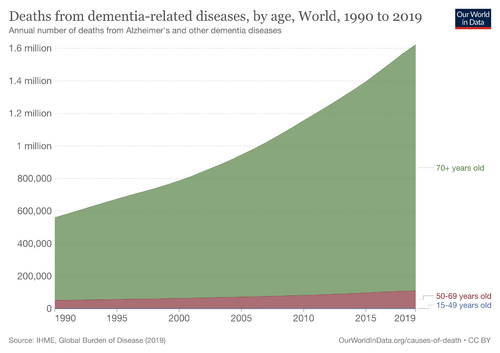Motoric Cognitive Risk Syndrome: Difference between revisions
No edit summary |
No edit summary |
||
| Line 13: | Line 13: | ||
The pathology of MCR is due to frontal lacunar infarcts, for example: | The pathology of MCR is due to frontal lacunar infarcts, for example: | ||
* white matter | * [[Grey and White Matter|White matter]] hyperintensity (predicts an increased risk of stroke, dementia, and death<ref>Debette S, Markus HS. [https://www.bmj.com/content/341/bmj.c3666 The clinical importance of white matter hyperintensities on brain magnetic resonance imaging: systematic review and meta-analysis.] Bmj. 2010 Jul 26;341.Available:https://www.bmj.com/content/341/bmj.c3666 (accessed 13.4.2023)</ref>). | ||
* | * Pre-motor and pre-[[Frontal Lobe|frontal gray matter]] atrophy in the pre-motor and pre-frontal cortex | ||
* Inflammatory changes | * Inflammatory changes | ||
* | * Genetic factors. | ||
[[Stroke|Cerebrovascular lesions]] and [[Cardiovascular Disease|cardiovascular disorder]]<nowiki/>s amplify the pathological changes. <ref name=":0">Xiang K, Liu Y, Sun L. [https://www.ncbi.nlm.nih.gov/pmc/articles/PMC8847709/ Motoric cognitive risk syndrome: symptoms, pathology, diagnosis, and recovery]. Frontiers in Aging Neuroscience. 2022 Feb 2;13:728799.Available:https://www.ncbi.nlm.nih.gov/pmc/articles/PMC8847709/ (accessed 12.4.2023)</ref> | |||
== Diagnosis == | == Diagnosis == | ||
Revision as of 07:00, 13 April 2023
Original Editor - Lucinda hampton
Top Contributors - Lucinda hampton
Introduction[edit | edit source]
Motoric cognitive risk syndrome (MCR) is a syndrome that develops prior to dementia. The syndrome consists of a slower gait, cognitive deficits and a risk factor for various geriatric syndromes including frailty and falls.[1] New research is showing that gait dysfunction can be a forerunner of dementia.[2]
MCR amongst older persons is estimated to be 10% in the 60 + age group, giving this population a higher risk of future disability. As the global burden of dementia increases tools are needed to identify those vulnerable to dementia and instigate a preventative management plan.
Pathology[edit | edit source]
The pathology of MCR is due to frontal lacunar infarcts, for example:
- White matter hyperintensity (predicts an increased risk of stroke, dementia, and death[3]).
- Pre-motor and pre-frontal gray matter atrophy in the pre-motor and pre-frontal cortex
- Inflammatory changes
- Genetic factors.
Cerebrovascular lesions and cardiovascular disorders amplify the pathological changes. [4]
Diagnosis[edit | edit source]
The diagnosis of MCR is an involved process comprising neuropsychological tests, biomarker assays, imaging studies, questionnaire-based evaluation, and motor function tests. [4]
Both neurological and non-neurological clinical abnormalities occur.
- Gait irregularities and accelerated functional decline (eg postural and balance dysfunction, memory loss, cognitive decline) stem from altered afferent sensory and efferent motor responses.
- Confusing visual, vestibular, and proprioceptive inputs. [4]
Management[edit | edit source]
Management of MCR is multimodal, including
- Lifestyle habits known to limit the disease progression. Similar to dementia recommendations. eg Cognitive, physical, and social activities
- Exercise
- Diet, nutritional supplements and vitamins known to support motor and cognitive improvement. eg vit D. A 2022 sudy showed identified that there is direct association between vitamin D deficeincy and MCR syndrome in older adults without dementia, and supplementation is advised.[1]
- Symptomatic drug treatment eg anti depressants
- Psychotherapeutic counseling[4]
Physiotherapy[edit | edit source]
Motor function tests for diagnosis and as treatment outcome measures include: including walking speed, dual-task gait tests, and ambulation ability.[4]
Exercise has been to shown to have a role in preventing cognitive decline. Home-based exercises with telephonic coaching are both safe as well as feasible in patients with Motoric Cognitive Risk syndrome[5]
Resources[edit | edit source]
- bulleted list
- x
or
- numbered list
- x
References[edit | edit source]
- ↑ 1.0 1.1 Le Floch M, Gautier J, Annweiler C. Vitamin D Concentration and Motoric Cognitive Risk in Older Adults: Results from the Gait and Alzheimer Interactions Tracking (GAIT) Cohort. International Journal of Environmental Research and Public Health. 2022 Oct 12;19(20):13086.Available:https://www.ncbi.nlm.nih.gov/pmc/articles/PMC9602422/ (accessed 13.4.2023)
- ↑ Meiner Z, Ayers E, Verghese J. Motoric cognitive risk syndrome: a risk factor for cognitive impairment and dementia in different populations. Annals of geriatric medicine and research. 2020 Mar;24(1):3.Available: https://www.ncbi.nlm.nih.gov/pmc/articles/PMC7370775/(accessed 12.4.2023)
- ↑ Debette S, Markus HS. The clinical importance of white matter hyperintensities on brain magnetic resonance imaging: systematic review and meta-analysis. Bmj. 2010 Jul 26;341.Available:https://www.bmj.com/content/341/bmj.c3666 (accessed 13.4.2023)
- ↑ 4.0 4.1 4.2 4.3 4.4 Xiang K, Liu Y, Sun L. Motoric cognitive risk syndrome: symptoms, pathology, diagnosis, and recovery. Frontiers in Aging Neuroscience. 2022 Feb 2;13:728799.Available:https://www.ncbi.nlm.nih.gov/pmc/articles/PMC8847709/ (accessed 12.4.2023)
- ↑ Ambrose AF, Gulley E, Verghese T, Verghese J. Home-based exercise program for older adults with Motoric Cognitive Risk syndrome: feasibility study. Neurodegenerative disease management. 2021 Jun;11(03):221-8.Available:https://www.futuremedicine.com/doi/full/10.2217/nmt-2020-0064 (accessed 12.4.2023)







